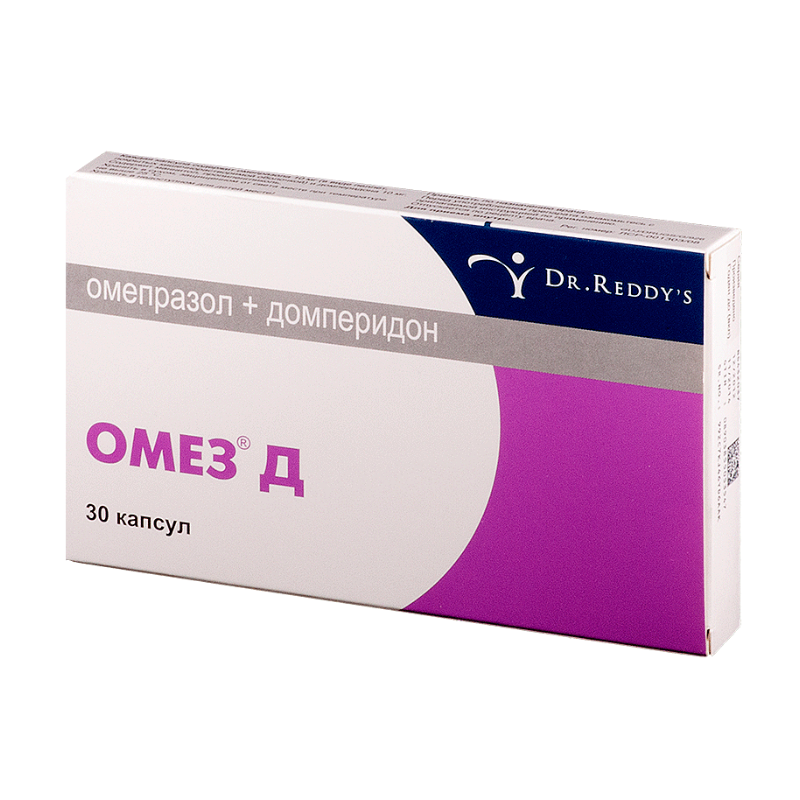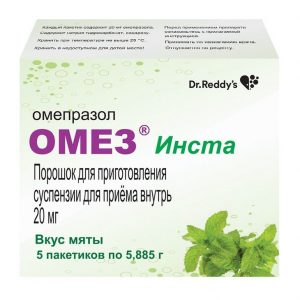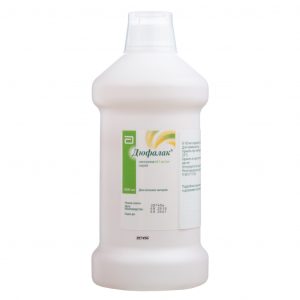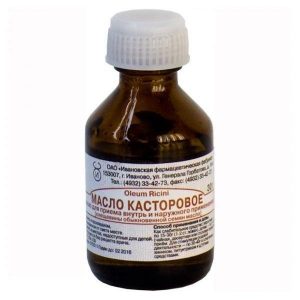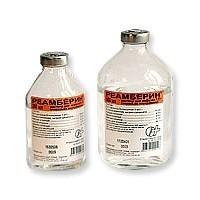Description
packaging 30 pcs
Pharmacological action
OMEZ D – proton pump inhibitor, antiemetic.
Pharmacodynamics
Domperidone. It increases the duration of peristaltic contractions of the antrum and duodenum, accelerates gastric emptying if this process slows down, increases the tone of the lower esophageal sphincter, and prevents the development of nausea and vomiting. Stimulates the release of prolactin from the pituitary gland. The antiemetic effect is probably due to a combination of peripheral (gastrokinetic) action and antagonism to dopamine receptors in the trigger zone of the brain. Domperidone has no effect on gastric secretion. It penetrates poorly through the BBB, so the use of domperidone is rarely accompanied by the development of extrapyramidal side effects, especially in adults.
omeprazole. It inhibits the enzyme H + -K + -ATPase (proton pump) in the parietal cells of the stomach and thereby blocks the final stage of the synthesis of hydrochloric acid. This leads to a decrease in the level of basal and stimulated secretion, regardless of the nature of the stimulus. After a single oral administration of the drug, the action of omeprazole occurs within 1 hour and lasts for 24 hours, the maximum effect is achieved after 2 hours. After discontinuation of the drug, secretory activity is fully restored after 3-5 days.
Pharmacodynamic rationale for combination. Omeprazole suppresses the secretion of hydrochloric acid, domperidone increases the tone of the lower esophageal sphincter and accelerates the emptying of the stomach, thereby reducing the activity of aggressive factors of gastric juice and the reflux of gastric contents into the esophagus.
Pharmacokinetics
Domperidone
Absorption. After oral administration, domperidone is rapidly absorbed. It has low bioavailability (about 15%). The reduced acidity of the gastric contents reduces the absorption of domperidone. Tmax in plasma – 1 h.
Distribution. Domperidone is widely distributed in various tissues, in the brain tissue its concentration is low. Plasma protein binding is 91 93%.
Metabolism. It is subjected to intense metabolism in the intestinal wall and liver.
Withdrawal.
It is excreted through the intestines (66%) and by the kidneys (33%), 10 and 1% of the dose are excreted unchanged, respectively. T1 / 2 is 7 9 hours, with severe renal failure it lengthens.
Omeprazole
Omeprazole is rapidly absorbed from the digestive tract, Tmax in plasma is 0.5 1 hours. Bioavailability is 30 40%. Plasma protein binding is about 90%. Omeprazole is almost completely metabolized in the liver. It is an inhibitor of the CYP2C19 enzyme system. T1 / 2 – 0.5 1 hours. It is excreted by the kidneys (70 80%) and with bile (20 30%). In chronic renal failure, excretion decreases in proportion to a decrease in creatinine clearance. In elderly patients, excretion decreases, bioavailability increases. With liver failure, bioavailability is 100%, T1 / 2 – 3 hours.
Indications
Treatment of dyspepsia and gastroesophageal reflux, poorly monotherapy with proton pump inhibitors or H2 receptor antagonists.
Contraindications
– Hypersensitivity to the active substance or to any of the excipients Omez DSR, – gastrointestinal bleeding, obstruction or perforation, in which stimulation of gastric motility can be dangerous
– prolactin – secreting pituitary (prolactinoma) tumors
– severe and moderate degree of liver failure
– patients with a history of conduction impairment, in particular lengthening of the QT interval on ECG
– patients severe electrolyte imbalances or serious heart diseases (e.g. congestive heart failure)
– combined with drugs that extend the QT interval
– combined th application of medicine, which are strong inhibitors of CYP3A4 (regardless of their effect, prolong QT)
– children under 16 years of age
Pregnancy and lactation
Contraindicated
Composition
Composition per capsule:
active ingredients: domperidone – 10 mg
omeprazole (in enteric coated pellets) – 10 mg srd
magnesium stearate,
microcrystalline cellulose,
silicon dioxide colloid first,
sodium lauryl sulfate,
sodium carboxymethyl starch, talc
adjuvants in enteric coating pellets:
sucrose, mannitol
,
sodium lauryl sulphate,
sodium hydrogen phosphate,
calcium carbonate,
lactose,
hypromellose,
methacrylic acid,
sulphide, hydrochloride, sodium hydroxide, sodium hydroxide, hydrochloride
gelatin,
indigo carmine,
titanium dioxide,
methylparaben,
propylparaben,
carmosine,
sodium lauryl sulfate,
water.
Dosage and administration
Inside, without chewing. The average recommended dose for adults is 1 capsule 2-3 times a day 30 minutes before meals with a glass of water. If necessary, the dose can be increased to 2 capsules 2 times a day. The course of treatment is 4-8 weeks.
Side effects
Domperidone
From the digestive system: transient intestinal cramps.
From the nervous system: extrapyramidal disorders (in children and people with increased permeability of the BBB).
Allergic reactions: skin rash, urticaria.
Other: hyperprolactinemia (galactorrhea, gynecomastia).
Omeprazole
From the digestive system: diarrhea or constipation, nausea, vomiting, flatulence, abdominal pain, dry mouth, taste disturbances, stomatitis, transient increase in the activity of liver enzymes in plasma in patients with a previous severe liver disease – hepatitis (in t with jaundice), impaired liver function.
From the nervous system: headache, dizziness, agitation, drowsiness, insomnia, paresthesia, depression, hallucinations in patients with severe concomitant somatic diseases, patients with a previous severe liver disease – encephalopathy.
From the musculoskeletal system: muscle weakness, myalgia, arthralgia.
From the hemopoietic system: leukopenia, thrombocytopenia in some cases – agranulocytosis, pancytopenia.
From the skin: itching, skin rash in some cases – photosensitivity, erythema multiforme, alopecia.
Allergic reactions: urticaria, angioedema, bronchospasm, interstitial nephritis, anaphylactic shock, fever.
Other: visual impairment, peripheral edema, increased sweating, gynecomastia rarely – the formation of gastric glandular cysts during prolonged treatment (due to inhibition of hydrochloric acid secretion, is benign, reversible).
Drug Interaction
Domperidone
Cimetidine, sodium bicarbonate, other antacid and antisecretory drugs reduce the bioavailability of domperidone.
Anticholinergics neutralize the action of domperidone.
Increase the concentration of domperidone in plasma: antifungal agents of the azole series, macrolide antibiotics, HIV protease inhibitors, nefazodone.
omeprazole
May reduce the absorption of esters, ampicillin, iron salts, itraconazole and ketoconazole (omeprazole increases gastric pH). Being an inhibitor of cytochrome P450, it may increase the concentration and reduce the excretion of diazepam, indirect-acting anticoagulants, phenytoin (drugs that are metabolized in the liver by CYP2C19 cytochrome), which in some cases may require a reduction in their doses. Increases the inhibitory effect on the hematopoiesis of other drugs.
Overdose
Domperidone
Symptoms: drowsiness, disorientation and extrapyramidal reactions.
Treatment: Activation of activated carbon in case of extrapyramidal reactions – anticholinergic, antiparkinsonian, antihistamines.
omeprazole
Symptoms: impaired vision, drowsiness, agitation, confusion, headache, increased sweating, dry mouth, nausea, arrhythmia.
Treatment: symptomatic. There is no specific antidote. Hemodialysis is not effective enough.
Storage conditions
In a dry, dark place, at a temperature not exceeding 25 ° C.
Expiration
2 Year
Active Domperydol
dosage form
dosage form
capsules
